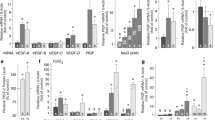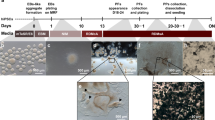Abstract
Background
To evaluate the knockdown of placental growth factor (PlGF) gene expression in human retinal pigment epithelium (RPE) cells and its effect on cell proliferation, apoptosis and angiogenic potential of RPE cells.
Methods
Human RPE cells were isolated by dispase I solution and cultured in DMEM/F12 supplemented with 10% fetal calf serum (FCS). A small interfering RNA (siRNA) corresponding to PlGF mRNA and a scrambled siRNA (scRNA) were introduced into the cells. Cell proliferation and cell death were examined by ELISA. PlGF mRNA and protein were quantified by real-time polymerase chain reaction (PCR) and western blot. The levels of gene expression for human retinal pigment epithelium-specific protein 65 kDa (RPE65), cellular retinaldehyde-binding protein (CRALBP) and tyrosinase were examined by real-time PCR. The angiogenic activity of RPE cell-derived conditioned media was assayed by a tube formation assay using human umbilical vein endothelial cells (HUVECs).
Results
At a final siRNA concentration of 20 pmol/ml, the transfection efficiency was about 80%. The amount of PlGF transcripts was reduced to 10% after 36 h of incubation, and the amount of PlGF protein in culture supernatant was significantly decreased. Suppression of PlGF gene had no effect on RPE cell proliferation and survival, and there were no notable changes in the transcript levels of RPE65, CRALBP or tyrosinase for the cultures treated by siRNA cognate to PlGF. Vascular tube formation was efficiently reduced in HUVECs.
Conclusions
Our findings present PlGF as a key modulator of angiogenic potential in RPE cells of the human retina.








Similar content being viewed by others
References
Klimanskaya I (2006) Retinal pigment epithelium. Meth Enzymol 418:169–194
Spilsbury K, Garrett KL, Shen WY, Constable IJ, Rakoczy PE (2000) Overexpression of vascular endothelial growth factor (VEGF) in the retinal pigment epithelium leads to the development of choroidal neovascularization. Am J Pathol 157:135–144
Witmer AN, Vrensen GFJ, Noorden V, Schlingemann RO (2003) Vascular endothelial growth factors and angiogenesis in eye disease. Prog Retin Eye Res 22:1–29
Ferrara N (2004) Vascular endothelial growth factor: basic science and clinical progress. Endocr Rev 25:581–611
Cashman SM, Bowman L, Christofferson J, Kumar-Singh R (2006) Inhibition of choroidal neovascularization by adenovirus-mediated delivery of short hairpin RNAs targeting VEGF as a potential therapy for AMD. Invest Ophthalmol Vis Sci 47:3496–3504
Lohela M, Bry M, Tammela T, Alitalo K (2009) VEGFs and receptors involved in angiogenesis versus lymphangiogenesis. Curr Opin Cell Biol 21:154–165
Reich SJ, Fosnot J, Kuroki A, Tang W, Yang X, Maguire AM, Bennett J, Tolentino MJ (2003) Small interfering RNA (siRNA) targeting VEGF effectively inhibits ocular neovascularization in a mouse model. Mol Vis 9:210–216
Luttun A, Autiero M, Tjwa M, Carmeliet P (2004) Genetic dissection of tumor angiogenesis: are PlGF and VEGFR-1 novel anti-cancer targets? Biochim Biophys Acta 1654:79–94
Rakic JM, Lambert V, Devy L, Luttun A, Carmeliet P, Claes C, Nguyen L, Foidart J, Noel A, Munaut C (2003) Placental growth factor, a member of the VEGF family, contributes to the development of choroidal neovascularization. Invest Ophthalmol Vis Sci 44:3186–3193
Nagy JA, Dvorak AM, Dvorak HF (2003) VEGF-A164/165 and PlGF. Roles in angiogenesis and arteriogenesis. Trends Cardiovasc Med 13:169–175
Michels S, Schmidt-Erfurth U, Rosenfeld PJ (2006) Promising new treatments for neovascular age-related macular degeneration. Expert Opin Investig Drugs 15:779–793
Cao Y (2009) Positive and negative modulation of angiogenesis by VEGFR1 ligands. Sci Signal 2:1–11
Adini A, Kornaga T, Firoozbakht F, Benjamin LE (2002) Placental growth factor is a survival factor for tumor endothelial cells and macrophages. Cancer Res 62:2749–2752
Schlingemann RO (2004) Role of growth factors and the wound healing response in age-related macular degeneration. Graefes Arch Clin Exp Ophthalmol 242:91–101
Shyu KG, Hung HF, Wang BW, Chang H (2008) Hyperbaric oxygen induces placental growth factor expression in bone marrow-derived mesenchymal stem cells. Life Sci 83:65–73
Hu J, Bok D (2001) A cell culture medium that supports the differentiation of human retinal pigment epithelium into functionally polarized monolayers. Mol Vis 7:14–19
Engelmann K, Valtink M (2004) RPE cell cultivation. Graefes Arch Clin Exp Ophthalmol 242:65–67
Elbashir SM, Harborth J, Lendeckel W, Yalcin A, Webwr K, Tuschl T (2001) Duplexes of 21-nucleotide RNAs mediate RNA interference in cultured mammalian cells. Nature 411:494–498
Zuker M (2003) Mfold web server for nucleic acid folding and hybridization prediction. Nucleic Acids Res 31:3406–3415
Schmittgen T D, Livak KJ (2008) Analyzing real-time PCR data by the comparative CT method. Nat Protoc 3:1101–1108
Reddy LS, Sarojamma V, Ramakrishna V (2006) RNAi in medicine: current and future perspectives. Biotechnol Mol Biol Rev 1:103–114
Pieramici DJ, Rabena MD (2008) Anti-VEGF therapy: comparison of current and future agents. Eye 22:1330–1336
Distler JHW, Jüngel A, Kurowska-Stolarska M, Michel BA, Gay RE, Gay S, Distler O (2005) Nucleofection: a new, highly efficient transfection method for primary human keratinocytes. Exp Dermatol 14:315–320
Cai H, Del Priore LV (2006) Gene expression profile of cultured adult compared to immortalized human retinal pigment epithelium. Mol Vis 12:1–14
Weleber RG (2005) Inherited and orphan retinal diseases: phenotypes, genotypes, and probable treatment groups. Retina 25:54–57
Kanuga N, Winton HL, Beauche’ne L, Koman A, Zerbib A, Halford S, Couraud P, Keegan D, Coffey P, Lund RD, Adamson P, Greenwood J (2002) Characterization of genetically modified human retinal pigment epithelial cells developed for in vitro and transplantation studies. Invest Ophthalmol Vis Sci 43:546–555
Ohno-Matsui K, Mori K, Ichinose S, Sato T, Wang J, Shimada N, Kojima A, Mochizuki M, Morita I (2006) In vitro and in vivo characterization of iris pigment epithelial cells cultured on amniotic membranes. Mol Vis 12:1022–1032
Kamba T, McDonald MD (2007) Mechanisms of adverse effects of anti-VEGF therapy for cancer. Br J Cancer 96:1788–1795
Enseleit F, Michels S, Ruschitzka F (2010) Anti-VEGF therapies and blood pressure: more than meets the eye. Curr Hypertens Rep 12:33–38
Michels S, Rosenfeld PJ, Puliafito CA, Marcus EN, Venkatraman AS (2005) Systemic bevacizumab (avastin) therapy for neovascular age-related macular degeneration: twelve-week results of an uncontrolled open-label clinical study. Ophthalmology 112:1035–1047
Staton CA, Stribbling SM, Tazzyman S, Hughes R, Brown NJ, Lewis CE (2004) Current methods for assaying angiogenesis in vitro and in vivo. Int J Exp Pathol 85:233–248
Acknowledgements
This work was supported by National Institute of Genetic Engineering and Biotechnology (NIGEB) through grant no.253. Our gratitude and sincere thanks to Zahra Ataei, Pezhman Fahim, Ali Talebian, Ahmad Gharabaghian, and Tahere Chamani for their contribution in completing this work.
Author information
Authors and Affiliations
Corresponding author
Rights and permissions
About this article
Cite this article
Akrami, H., Soheili, ZS., Sadeghizadeh, M. et al. PlGF gene knockdown in human retinal pigment epithelial cells. Graefes Arch Clin Exp Ophthalmol 249, 537–546 (2011). https://doi.org/10.1007/s00417-010-1567-7
Received:
Revised:
Accepted:
Published:
Issue Date:
DOI: https://doi.org/10.1007/s00417-010-1567-7




